
 |
Search | FAQ | US Titles | UK Titles | Memories | VaporWare | Digest | |||||||
| GuestBook | Classified | Chat | Products | Featured | Technical | Museum | ||||||||
| Downloads | Production | Fanfares | Music | Misc | Related | Contact | ||||||||
| Featured CED VideoDisc No. 30 - Fall 2003 | ||||||||||||||
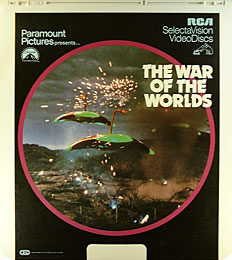 This was chosen as the featured CED for the science fiction category partly because the Earth and Mars are presently in the tail end of their nearest orbital proximity in 60,000 years. As viewers of this movie (and readers of the H.G. Wells novel) know, the Martians launched their attack on Earth when the two planets were in such an opposition (it's called conjunction when the two planets are on opposite sides of the sun). This season also marks the 50th anniversary of this movie, which was a hit in movie theaters in the Fall of 1953. "The War of the Worlds" is also the earliest color science fiction movie released on CED. In fact, it is one of the first color sci-fi movies ever to come out, and that, coupled with its great special effects courtesy of producer George Pal no doubt contributed to its theatrical success. Like the Martians in the movie, Hollywood seems to have a habit of doing things in threes, so War of the Worlds (Paramount) was followed by two more special effect extravaganzas, This Island Earth (Universal) in 1955, and Forbidden Planet (MGM) in 1956. After that, there was a near drought in big-budget, sci-fi special effects until 2001: A Space Odyssey came along in 1968. Then another void took place until 1977, when Star Wars re-invigorated the blockbuster special effects that have continued unabated to the present day.
This was chosen as the featured CED for the science fiction category partly because the Earth and Mars are presently in the tail end of their nearest orbital proximity in 60,000 years. As viewers of this movie (and readers of the H.G. Wells novel) know, the Martians launched their attack on Earth when the two planets were in such an opposition (it's called conjunction when the two planets are on opposite sides of the sun). This season also marks the 50th anniversary of this movie, which was a hit in movie theaters in the Fall of 1953. "The War of the Worlds" is also the earliest color science fiction movie released on CED. In fact, it is one of the first color sci-fi movies ever to come out, and that, coupled with its great special effects courtesy of producer George Pal no doubt contributed to its theatrical success. Like the Martians in the movie, Hollywood seems to have a habit of doing things in threes, so War of the Worlds (Paramount) was followed by two more special effect extravaganzas, This Island Earth (Universal) in 1955, and Forbidden Planet (MGM) in 1956. After that, there was a near drought in big-budget, sci-fi special effects until 2001: A Space Odyssey came along in 1968. Then another void took place until 1977, when Star Wars re-invigorated the blockbuster special effects that have continued unabated to the present day.
Coupled with its special effects, this movie also creates a sense of realism by combining solid science with effective use of quality archive footage. The sense of accurate science is conveyed right at the start of the movie when Sir Cedric Hardwicke begins his introductory narration with words similar to the first page of the novel, followed by a tour of the solar system from the outer planets inward:
"No one would have believed in the middle of the twentieth century that human affairs were being watched keenly and closely by intelligences greater than man's. Yet, across the gulf of space on the planet Mars, intellects vast and cool and unsympathetic regarded our Earth with envious eyes, slowly and surely drawing their plans against us."
The planet Venus is conveniently left out of the solar system tour, as that was the one planet whose surface conditions could only be speculated upon in the 1950's. It's omission is interesting, as Venus is the only other planet besides Earth and Mars that figures into Wells' book. The most effective use of archive footage is that of the Flying Wing used to deliver the atomic bomb, although unbeknownst to the public, that airplane ceased to exist a few years before this movie was made. The Flying Wing's strong resemblance to the present-day B-2 bomber is the one realistic aspect of this movie that seems to transcend its 1950's setting.
RCA historians will note that 1953 was also a big year for the corporation. RCA introduced the hugely popular B&W 630TS TV right after World War II in 1946, initiating the start of the television age, and by 1950 the company proposed a backwards-compatible, all-electronic color system to the FCC. But in what many viewed as a draconian move, the FCC selected a partly mechanical "whirling disc" color system proposed by CBS that was not compatible with the existing B&W receivers. RCA head David Sarnoff was not about to give up without a fight, and using his considerable political clout, he forced a second NTSC (National Television Standards Committee) to convene, and at the same time pressed scientists and engineers at RCA Labs to improve the all-electronic RCA system. Sarnoff made the cover of TIME Magazine during this period, and I've wondered if the mention in this movie of scientist/hero Dr. Clayton Forrester (Gene Barry) appearing on the cover of TIME was not an indirect homage to him. On December 17, 1953 the FCC announced final approval of the RCA system, prompting David Sarnoff to truly jump for joy. Since the ratification of the color TV spec in 1953, televisions have changed dramatically in their internal circuitry. At that time they were based on vacuum tube technology and contained no transistors. With all the progress that has been made in electronic technology, it's a testament to the immutability of the NTSC specification that it is still the prevailing standard for television transmission 50 years later.
The makers of "The War of the Worlds" took advantage of the press color TV was getting in the early 1950's by incorporating the technology into the plot of the movie. At that time the concept of RGB (red-green-blue) color was as high-tech as something like Wi-Fi computing is today. In the movie, the Martians are using a cool-looking RGB color camera to remotely look at things from the safety of their ships, and the Martian eye itself is clearly based on the RGB concept. Although RCA's first color TV, the CT-100 did not become available until April 1954, the company did publish a book Practical Color Television in late 1953 going into great detail on RGB color, and the concept was well covered in publications like Popular Science. There were no doubt many viewers in those initial audiences enthralled by the relevance of the Martian technology they were seeing. It will be interesting to see if the remake of the movie presently under development will bring it up to 21st century standards or revert to the 19th century technology of the H.G. Wells book.
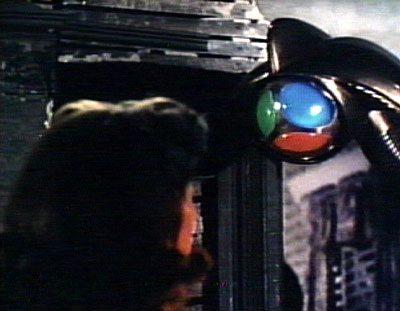
|
Martian Television Camera
In a scene 11:07 into Side 2 of the CED, Sylvia Van Buren (Ann Robinson) is startled by the Martian RGB TV camera extended from their ship on a long gooseneck. The optics of the Martian camera are plain to see, while human TV cameras in 1953, like the RCA model TK-40, hid their complex optics inside bulky casings. |
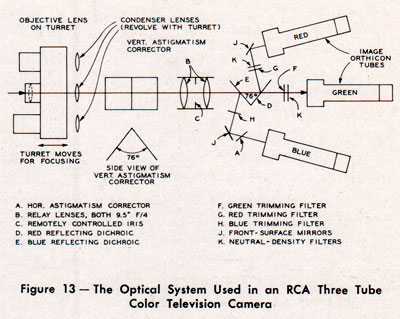
|
RCA TK-40 Television Camera
A diagram from the 1953 RCA book Practical Color Television showing how the optics of the company's TK-40 three-tube color TV camera work. The TK-40 is shown being operated on the cover of the book. In this diagram, light enters the camera through one of three objective lenses mounted in a turret on the outside of the camera. Zoom optics were poor in the 1950's, so these three lenses provided fixed focal lengths corresponding to wide-angle, normal, and telephoto. The optics of the camera initially send the image to point E, a blue reflecting dichroic mirror. A dichroic mirror has the property of passing all light except the color it is designed to reflect. In the case at E, the dichroic mirror passes red and green light, but reflects blue light. Blue light is reflected to the face of a front-surface mirror J which re-reflects the light, focusing it upon the face of an image orthicon camera tube designed to operate from only the blue light of the televised scene. The red and green light passes through the blue dichroic mirror to another dichroic mirror D, in this case a red reflecting dichroic mirror. Green light continues to pass through this mirror and is focused on the face of the green camera tube. Red light is reflected by the red dichroic mirror and is re-reflected by another front-surface mirror J to the face of the red camera tube. |
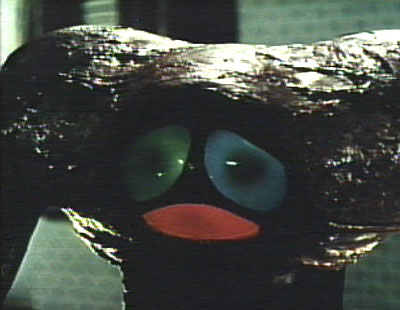
|
Live Martian
A live Martian shown briefly 12:11 into Side 2 of the CED. As can be seen, the biological eye of the Martian is very similar to the electronic eye of their television camera. The three-fingered, one-eyed nature of these Martians made them very creepy looking for a 1950's sci-fi movie, as most aliens back then were two-eyed and somewhat human looking. These Martians were so effective that the same basic design was used in the 1988 TV series "War of the Worlds". But that series de-emphasized the RGB nature of the eye, since by the 1980's it was somewhat quaint. |
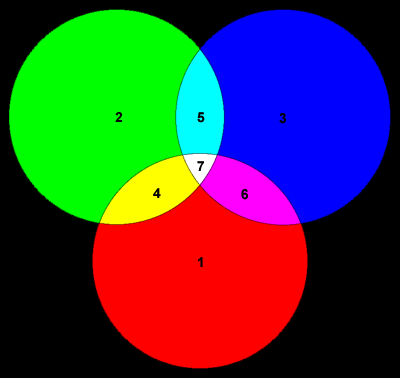
|
RGB Model of Martian Eye
The RGB model as it pertains to the Martian eye, color TV cameras, or color television tubes in general. The seven numbers indicate the seven colors produced by mixing red, green, and blue light in various combinations at equal luminosity. To commemorate the golden anniversary of the RCA RGB color standard during Christmas 2003, CED Magic sent out a 7-Color SelectaVision gift pen containing three LED's that mix their light based on this same RGB model to ideally produce the seven colors shown in the following table:
But owners of the gift pen will note that the yellow, magenta, and white positions on the pen's pushbutton do not correspond to the idealized colors shown in this diagram. This is because the luminosity of the green and blue LED's is considerably higher than that of the red LED. |
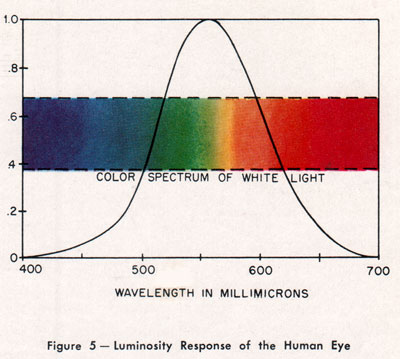
|
Human Luminosity Response
This diagram from the 1953 RCA book Practical Color Television shows the luminosity response of the human eye, and also provides an explanation for why most representations of the rainbow (such as the CED Magic logo) use six colors. The maximum responsiveness of the human eye is right on the boundary between green and yellow, so choosing three colors on either side of that boundary yields violet, blue, green, yellow, orange, and red. The outdated millimicron unit used in this diagram has been replaced by the equivalent nanometer (nm) unit. |
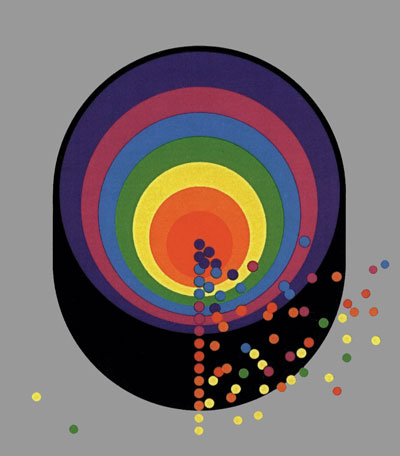
|
SelectaVision Logo
But some logos, such as the SelectaVision engineering logo, represent the rainbow with seven colors. This dates back to Isaac Newton's discovery of the solar spectrum using a prism, and is actually a more scientifically accurate representation, breaking visible light down into seven roughly equal segments. The mnemonic ROY G BIV is an easy way to remember the seven colors:
Notice in the SelectaVision logo, RCA swapped the order of the indigo and violet rings, probably to create a better contrast. |

|
Color Wheel
While RCA's RGB model represents an electronic interpretation of color, the wheel shown here is an artistic interpretation using red, yellow, and blue as the primary colors. These primary colors are represented by the three quadrilaterals at the center of the wheel, and equally mixing them yields the secondary colors of violet (R-B), green (B-Y), and orange (Y-R) represented by the three isosceles triangles at the center. The wheel itself consists of twelve colors, represented by the three primary colors, the three secondary colors, and six tertiary colors produced by mixing a primary color with an adjacent secondary color. Colors opposite one another on the wheel are complementary, while those separated by two or three color positions are considered contrasting. |
This table lists the CED titles I have classified as science fiction titles. As with previous genre classifications, the goal here is to assign each CED title to just one genre for the purpose of arranging the discs on shelves. So when I get around to the Western genre, a title like Westworld won't be listed, because I already assigned it to the Sci-Fi genre.
|
H. G. Wells Filmography
|
|
|
Title of Work
|
Year of Publication
|
| The Time Machine 2 3 4 | 1895 |
| The Island of Dr. Moreau 2 3 4 5 | 1896 |
| The Invisible Man 2 3 4 5 6 7 | 1897 |
| The War of the Worlds 2 | 1898 |
| The First Men in the Moon 2 | 1901 |
| The Food of the Gods 2 3 | 1904 |
| Empire of the Ants | 1905 |
| The Shape of Things to Come 2 | 1933 |
After download, unzip the Windows file (the Mac file is ready to install as is), and use the handheld computer install program to prepare it for transfer. During the next sync operation the war-worlds.prc file will be placed on your Palm OS, Pocket PC, or Windows CE handheld, and the complete 1898 HG Wells book may be read on the device using a reader application like iSilo.